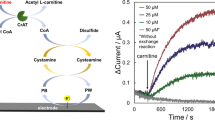Summary
The use of carnitine-dehydrogenase from Pseudomonas putida for the spectrophotometric determination (λ= 340 nm) of l-carnitine in amounts of 5–50 nmol is described. More than 99% of l-carnitine is oxidized in the presence of 3.2 μmol NAD+ and 2U of the enzyme in glycine buffer pH 9.95–10.05. If the NADH formed is reoxidized by phenazine methosulfate and tetrazolium salt, the formazan production (λ=500 nm) is proportional to l-carnitine already at pH 8–9. It is possible to detect up to 2 nmol of l-carnitine in this test system.
Zusammenfassung
Es wird eine Methode beschrieben, die eine quantitative Bestimmung von l-Carnitin durch Einsatz von Carnitindehydrogenase aus Pseudomonas putida in einem einfachen optischen Test bei 340 nm ermöglicht. Bei Durchführung der Reaktion im pH-Bereich zwischen 9,95 und 10,05 kann man nach einer Inkubation bei 30° C für 30 min einen Umsatz von mehr als 99% erreichen, wenn mindestens 2 U Enzym eingesetzt werden. Eine Linearität zwischen l-Carnitinkonzentration und Extinktionsdifferenz ist allerdings nur bis zu einer Konzentration von 25−30 μmol/l gegeben. Bei Kopplung der Reaktion mit Phenazinmethosulfat und Iodnitrotetrazoliumchlorid kann ein quantitativer Umsatz bereits im pH-Bereich von 8–9 erzielt werden. Die Konzentrationszunahme des sich bildenden Formazans kann bei 500 nm verfolgt werden. Es können so noch etwa 2 nmol l-Carnitin sicher nachgewiesen werden.
Similar content being viewed by others
Literatur
Pearson DJ, Tubbs PK, Chase JFA (1970) In: Bergmeyer HU (Hrsg) Methoden der enzymatischen Analyse, Akademie-Verlag, Berlin, S 1710–1723
Aurich H, Kleber H-P, Schöpp W (1967) Biochem Biophys Acta 139:505–507
Aurich H, Kleber H-P, Sorger H, Tauchert H (1968) Eur J Biochem 6:196–201
Schöpp W, Sorger H, Kleber H-P, Aurich H (1969) Eur J Biochem 10:56–60
Schöpp W, Kleber H-P, Aurich H (1971) Acta Biol Med Ger 27:69–75
Vandecasteele J-P (1980) Appl Environ Microbiol 39:327–334
Müller DM, Strack E (1972) Hoppe-Seyler's Z Physiol Chem 353:618–622
Chakrabarty AM, Chou G, Gunsalus JC (1973) Proc Natl Acad USA 70:1137–1140
Stanier RY, Palleroni NJ, Doudoroff M (1966) J Gen Microbiol 43:159–271
Kleber H-P, Seim H, Aurich H, Strack E (1978) Arch Microbiol 116:213–220
Schöpp W, Grunow M, Tauchert H, Aurich H (1976) FEBS Lett 68:198–202
Dickenson Ch, Dickinson FM (1977) Biochem J 161:73–79
Bohmer T, Bergrem H, Eiklid K (1978) Lancet I 126–128
Vorberg S, Schöpp W, Tauchert H (1983) Monatshefte Chem 114:563–569
Author information
Authors and Affiliations
Rights and permissions
About this article
Cite this article
Schöpp, W., Schäfer, A. Quantitative Bestimmung von l-Carnitin mit Hilfe von Carnitindehydrogenase aus Pseudomonas putida . Z. Anal. Chem. 320, 285–289 (1985). https://doi.org/10.1007/BF00469589
Received:
Issue Date:
DOI: https://doi.org/10.1007/BF00469589




